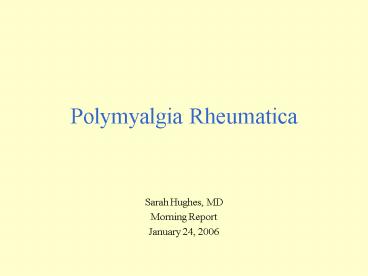Polymyalgia Rheumatica - PowerPoint PPT Presentation
1 / 22
Title:
Polymyalgia Rheumatica
Description:
PMR is an inflammatory condition of unknown etiology ... Fibromyalgia. Late-onset spondyloarthropathy. Differential Diagnosis. Malignancy ... – PowerPoint PPT presentation
Number of Views:607
Avg rating:3.0/5.0
Title: Polymyalgia Rheumatica
1
Polymyalgia Rheumatica
- Sarah Hughes, MD
- Morning Report
- January 24, 2006
2
Polymyalgia Rheumatica
- PMR is an inflammatory condition of unknown
etiology - Characterized by aching stiffness in the
shoulder and pelvic girdles and the neck - Occurs in people 50 yrs old
- Usually responds to low doses of steroids
- Is related to Giant Cell Arteritis, with
biopsy-proven GCA present in about 4-21
3
Epidemiology
- Prevalence of 1 case for every 133 people over 50
yrs of age. - Incidence increases with age, peaks 70-80yrs
- Females Males in all age groups (21)
- Higher incidence at higher lattitudes,
Scandinavian countries - Rarely reported in blacks, but appears to have
the same presentation, course, and response to
treatment.
4
Diagnostic Criteria
- Criteria most frequently used for diagnostic
purposes are empirical. - Those of Hunder at Mayo clinic Healey at Mason
clinic are most widely used. - A current ongoing international project is aiming
to develop new diagnostic and classification
criteria and validate them.
5
Diagnostic Criteria
Salvarani, C. Polymyalgia Rheumatica. Best
Practice Research Clinical Rheum. 2004. Vol.
18, No. 5, pp. 705-722.
6
Etiology
- Probably polygenic in which multiple
environmental and genetic factors influence
susceptibility and severity. - Possible infectious triggers
- Viruses adenovirus, RSV, parvovirus,
parainfluenza - Bacteria Mycoplasma, Chlamydia pneumoniae
7
Etiology
- Genetic component probable
- HLA-DRB104 and -DRB101 appear to be most
associated with susceptibility to PMR - Genetic polymorphisms of additional genes
involved in initiation and regulation of
inflammatory reaction - ICAM-1, TNF, IL-1 receptor antagonists
- Possible subclinical vasculitis
8
Clinical Manifestations
- Persistent pain (for at least 1 month)
- Aching morning stiffness in neck, shoulder and
pelvic girdles lasting 30 min. - Discomfort is bilateral, worse w/ movement, and
usually interferes w/ ADL - Evidence of systemic involvement
9
Clinical Manifestations
- Shoulder pain is presenting sign in 70-95
- Hips and neck 50-70
- Pain usually radiates distally towards elbows and
knees - Systemic signs seen in 1/3
- Fever
- Malaise/fatigue
- Anorexia, weight loss
10
Clinical Manifestations
- Exam reveals little evidence of proximal joint
swelling or tenderness - MRI studies have shown subdeltoid subacromial
bursitis are more prominent than actual joint
synovitis
11
Clinical Manifestations
Cantini, F. Polymyalgia Rheumatica and Giant Cell
Arteritis. NEJM. 2002. Vol. 347, No. 4, pp.
261-271.
12
Clinical Manifestations
- Distal manifestations also seen in 1/2 cases
- Nonerosive, self-limiting, asymmetric peripheral
arthritis (knee/wrist) - Carpal tunnel syndrome
- Distal extremity swelling pitting edema over
dorsum of hands and wrists, ankles and feet.
13
Clinical Manifestations
Cantini, F. Polymyalgia Rheumatica and Giant Cell
Arteritis. NEJM. 2002. Vol. 347, No. 4, pp.
261-271.
14
Labs
- ESR 40mm/hr (nl in 7-20)
- CRP less influenced by other factors, may be more
sensitive direct measure - IL-6
- Modest anemia of chronic disease in 2/3
- Mildly abnormal LFTs in 1/3
- Rheum factor and ANA usually negative
- Muscle enzymes are normal
15
Differential Diagnosis
- SLE
- Look for pleuritis or pericarditis
- Leukopenia or thrombocytopenia
- Check anti-dsDNA and anti-ENA antibodies
- RA
- Small joints of hands/feet
- Only partially responsive to steroids
- Considerable overlap b/t PMR seronegative RA
16
Differential Diagnosis
- Polymyositis
- Symmetric proximal muscle weakness
- Pain not prominent
- Elevated CK, aldolase abnormal EMG, myositis on
muscle biopsy - Fibromyalgia
- Late-onset spondyloarthropathy
17
Differential Diagnosis
- Malignancy
- Solid (kidney, ovary, stomach)
- Hematologic (myeloma, primary amyloidosis)
- Infection
- Bacterial endocarditis
- Lack of adequate response to prednisone and
presence of atypical features should make one
consider these
18
Treatment Course
- Corticosteroids are drugs of choice (10-20mg/day)
- Trial of NSAIDs for 2-4 weeks if mild
- Complete or nearly complete resolution of sx is
seen in a few days - absence of improvement
should cause one to question diagnosis. - Relapses do occur, more frequent in first 1-2
years.
19
Treatment Course
- Follow ESR or CRP
- Treatment for 1-2 years is often required,
sometimes longer - Watch for corticosteroid adverse effects!
- Methotrexate proposed as CS-sparing drug
- Infliximab
- Depot Methylprednisolone had similar efficacy
fewer adverse effects
20
Summary
- PMR is a common illness in certain populations
- Incidence increases after the age of 50 and peaks
between 70-80 years of age. - Biopsy-proven GCA has been observed in 4-21 of
pts with PMR - Arthroscopic, radioisotopic, and MRI studies
indicate presence of synovitis in proximal joints
and periarticular structures.
21
Summary
- Distal manifestations are present in about half
of the cases - About 7-20 have normal ESR at diagnosis
- A course of treatment of 1-2 years is often
required, with some patients having a more
chronic, relapsing course. - Overall mortality is not effected.
22
References
- Bengtsson, B. Chapter 24 Polymyalgia Rheumatica.
Primer on the Ruematologic Diseases. 1997.
Arthritis Foundation. Pp 305-6. - Cantini, F. Polymyalgia Rheumatica and Giant Cell
Arteritis. NEJM. 2002. Vol. 347, No. 4, pp.
261-271. - Goodwin, JS. The very low prevalence of
polymyalgia rheumatica in blaks may be an
artifact. J Am Geriatrt Soc. 1990. Jul vol. 38,
No. 7, pp. 824-6. - Salvarani, C. Polymyalgia Rheumatica. Best
Practice Research Clinical Rheumatology. 2004.
Vol. 18, No.5, pp. 705-722. - Sanford, RG. Polymyalgia rheumatica and temporal
arteritis in blacks -- clinical features and HLA
typing. J Rheumatology. 1977 Winter. Vol. 4, No.
4, pp. 435-42. - UpToDate.com































